"The Home and the World" by Rabindranath Tagore is a story that unfolds in colonial India, where tradition clashes with modern ideals. It centers on Bimala, a young woman, her husband Nikhil, and the passionate nationalist Sandip Babu, creating a love triangle complicated by nationalistic feelings. Bimala's journey starts with a struggle to balance her traditional roots with new ideas and political excitement and she thinks back on her upbringing and marriage with Nikhil. The stirring for change in Bengal and her connection to Sandip Babu, who represents a strong desire for political change, adds to her confusion. This sets the stage for Bimala's conflicts and involvement in complex romantic and ideological issues that will put her understanding of love, loyalty, and herself to the test.

The Home and the World
By Rabindranath Tagore
Caught between her loving husband and a charismatic nationalist, a young woman in colonial India confronts the pull of tradition against the fervor of revolution.
Summary
About the AuthorRabindranath Tagore was a Bengali poet, writer, playwright, composer, philosopher, social reformer, and painter of the Bengal Renaissance. He reshaped Bengali literature and music as well as Indian art with Contextual Modernism in the late 19th and early 20th centuries. Author of the "profoundly sensitive, fresh and beautiful" poetry of Gitanjali, in 1913 Tagore became the first non-European and the first lyricist to win the Nobel Prize in Literature. Tagore's poetic songs were viewed as spiritual and mercurial; where his elegant prose and magical poetry were widely popular in the Indian subcontinent. He was a fellow of the Royal Asiatic Society. Referred to as "the Bard of Bengal", Tagore was known by the sobriquets Gurudeb, Kobiguru, and Biswokobi.
Rabindranath Tagore was a Bengali poet, writer, playwright, composer, philosopher, social reformer, and painter of the Bengal Renaissance. He reshaped Bengali literature and music as well as Indian art with Contextual Modernism in the late 19th and early 20th centuries. Author of the "profoundly sensitive, fresh and beautiful" poetry of Gitanjali, in 1913 Tagore became the first non-European and the first lyricist to win the Nobel Prize in Literature. Tagore's poetic songs were viewed as spiritual and mercurial; where his elegant prose and magical poetry were widely popular in the Indian subcontinent. He was a fellow of the Royal Asiatic Society. Referred to as "the Bard of Bengal", Tagore was known by the sobriquets Gurudeb, Kobiguru, and Biswokobi.



















